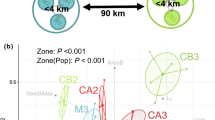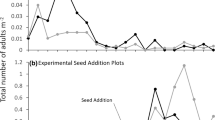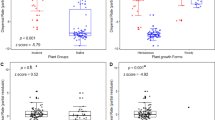Abstract
As founders of new invasions or survivors of control efforts, small populations can play important roles in biological invasions. Theory and models have explored how population size can affect invasion probability and dynamics. In contrast, there have been few studies of small population size and invasions in the wild, especially for plants. Here, we identified 21 naturally-occurring small populations of the invasive annual grass Lolium multiflorum to elucidate the effects of population size on plant reproduction and potential invasiveness. We compared seed production of focal plants to three attributes of the population: population size, a focal plant’s floret neighborhood (a measure of the size and pollen production of nearby potential pollen donors), and focal plant size. Population size and floret neighborhood were weighted by inter-plant distance to account for variation in density and spatial arrangement. Variation among populations in the proportion of florets producing a seed was explained by population size and floret neighborhood. In contrast, the focal plant’s size did not significantly affect the seed production proportion. A decrease in reproduction due to the size and density of the population (while accounting for maternal size) is an Allee effect, which may limit the ability to predict invasion risks and rates early in the invasion process, particularly if the effect is not recognized.


Similar content being viewed by others
References
Aizen MA, Harder LD (2007) Expanding the limits of the pollen-limitation concept: effects of pollen quantity and quality. Ecology 88:271–281
Ayres DR, Strong DR, Zaremba K (2004) Extinction of a common native species by hybridization with an invasive congener. Weed Tech 18:1288–1291
Berec L, Angulo E, Courchamp F (2007) Multiple Allee effects and population management. Trends Ecol and Evol 22:185–191
Busi R, Yu Q, Barrett-Lennard R, Powles S (2008) Long distance pollen-mediated flow of herbicide resistance genes in Lolium rigidum. Theor Appl Genet 117:1281–1290
California Invasive Plant Council (2004) Weed worker’s handbook. California Invasive Plant Council, Berkeley
Cappuccino N (2004) Allee effect in an invasive alien plant, pale swallow-wort Vincetoxicum rossicum (Asclepiadaceae). Oikos 106:3–8
Collinge SK, Ray C, Gerhardt F (2011) Long-term dynamics of biotic and abiotic resistance to exotic species invasion in restored vernal pool plant communities. Ecol Appl 21:2105–2118
Courchamp F, Berec L, Gascoigne J (2008) Allee effects in ecology and conservation. Oxford University Press, Oxford
Crampton B (1974) Grasses in California. University of California Press, Berkeley
Cunliffe KV, Vecchies AC, Jones ES, Kearney GA, Forster JW, Spangenberg GC, Smith KF (2004) Assessment of gene flow using tetraploid genotypes of perennial ryegrass (Lolium perenne L.). Aust J Agric Res 55:389–396
Davis HG, Taylor CM, Lambrinos JG, Strong DR (2004) Pollen limitation causes an Allee effect in a wind-pollinated invasive grass (Spartina alterniflora). Proc Natl Acad Sci (USA) 101:13804–13807
Dawson K, Veblen KE, Young TP (2007) Experimental evidence for an alkali ecotype of Lolium multiflorum, an exotic invasive annual grass in the Central Valley, CA, USA. Biol Invasions 9:327–334
Dawson W, Mndolwa AS, Burslem DFRP, Hulme PE (2008) Assessing the risks of plant invasions arising from collections in tropical botanical gardens. Biodivers Conserv 17:1979–1995
Drury KLS, Drake JM, Lodge DM, Dwyer G (2007) Immigration events dispersed in space and time: Factors affecting invasion success. Ecol Model 206:63–78
Elam D, Ridley CE, Goodell K, Ellstrand NC (2007) Population size and relatedness affect fitness of a self-incompatible invasive plant. Proc Natl Acad Sci (USA) 104:549–552
Fearon CH, Hayward MD, Lawrence MJ (1983) Self-incompatibility in ryegrass V. Genetic control, linkage and seed-set in diploid Lolium multiflorum. Hered 50:35–46
Firestone JL (2011) Demographic and genetic limitations on reproduction due to small population size in Lolium multiflorum: Allee effects in an invasive grass. Dissertation, University of California, Davis
Griffiths DJ (1950) The liability of seed crops of perennial ryegrass (Lolium perenne) to contamination by wind-borne pollen. J Agric Sci 40:19–38
Hendry GW (1931) The Adobe brick as a historical source: reporting further studies in adobe brick analysis. Agric Hist 5:110–127
Jasieniuk M, Ahmad R, Sherwood AM, Firestone JL, Perez-Jones A, Lanini WT, Mallory-Smith C, Stednick Z (2008) Glyphosate-resistant Italian ryegrass (Lolium multiflorum) in California: distribution, response to glyphosate, and molecular evidence for an altered target enzyme. Weed Sci 56:496–502
Kramer AM, Dennis B, Liebhold AM, Drake JM (2009) The evidence for Allee effects. Pop Ecol 51:341–354
Leung B, Drake J, Lodge D (2004) Predicting invasions: propagule pressure and the gravity of Allee effects. Ecology 85:1651–1660
Levin DA, Kelley CD, Sarkar S (2009) Enhancement of Allee effects in plants due to self-incompatibility alleles. J Ecol 97:518–527
Liebhold A, Bascompte J (2003) The Allee effect, stochastic dynamics and the eradication of alien species. Ecol Lett 6:133–140
Marshall C, Ludlam D (1989) The pattern of abortion of developing seeds in Lolium perenne L. Ann Bot 63:19–27
Morrison SA, Macdonald N, Walker K, Lozier L, Shaw MR (2007) Facing the dilemma at eradication’s end: uncertainty of absence and the Lazarus effect. Front Ecol Environ 5:271–276
Mustajärvi K, Siikamäki P, Rytkönen S, Lamm A (2001) Consequences of plant population size and density for plant-pollinator interactions and plant performance. J Ecol 89:80–87
Naylor REL (1980) Effects of seed size and emergence time on subsequent growth of perennial ryegrass. New Phytol 84:313–318
Niesenbaum RA (1999) The effects of pollen load size and donor diversity on pollen performance, selective abortion, and progeny vigor in Mirabilis jalapa. Am J Bot 86:261–268
Pejchar L, Mooney HA (2009) Invasive species, ecosystem services and human well-being. Trends Ecol Evol 24:497–504
Rice KJ (1990) Reproductive hierarchies in Erodium: Effects of variation in plant density and rainfall distribution. Ecology 71:1316–1322
Rognli OA, Nilsson NO, Nurminiemi M (2000) Effects of distance and pollen competition on gene flow in the wind-pollinated grass Festuca pratensis Huds. Heredity 85:550–560
Sherwood A, Jasieniuk M (2009) Molecular identification of weedy glyphosate-resistant Lolium (Poaceae) in California. Weed Res 49:354–364
Sih A, Baltus M-S (1987) Patch size, pollinator behavior and pollinator limitation in catnip. Ecology 68:1679–1690
Simberloff D (2009) The role of propagule pressure in biological invasions. Annu Rev Ecol Evol Syst 40:81–102
Skurka Darin G, Schoenig S, Barney JN, Panetta FD, DiTomaso JM (2010) WHIPPET: a novel tool for prioritizing invasive plant populations for regional eradication. J Environ Manag 92:131–139
Taylor CM, Hastings A (2005) Allee effects in biological invasions. Ecol Lett 8:895–908
Tobin PC, Robinet C, Johnson DM, Whitmire SL, Bjørnstad ON, Liebhold AM (2009) The role of Allee effects in gypsy moth, Lymantria dispar (L.), invasions. Popul Ecol 51:373–384
Tobin PC, Berec L, Liebhold AM (2011) Exploiting Allee effects for managing biological invasions. Ecol Lett 14:615–624
van Kleunen M, Johnson SD (2005) Testing for ecological and genetic Allee effects in the invasive shrub Senna didymobotrya (Fabaceae). Am J Bot 92:1124–1130
van Treuren R, Goossens PJ, Ševčiková M (2006) Variation in effective pollination rates in relation to the spatial and temporal distribution of pollen release in rejuvenated perennial ryegrass. Euphytica 147:367–382
Vergeer P, Rengelink R, Copal A, Ouborg NJ (2003) The interacting effects of genetic variation, habitat quality and population size on performance of Succisa pratensis. J Ecol 91:18–26
von Holle B, Simberloff D (2005) Ecological resistance to biological invasion overwhelmed by propagule pressure. Ecology 86:3212–3218
Wagenius S (2006) Scale dependence of reproductive failure in fragmented Echinacea populations. Ecology 87:931–941
Wagenius S, Lonsdorf E, Neuhauser C (2007) Patch Aging and the S-Allee Effect: breeding system effects on the demographic response of plants to habitat fragmentation. Am Nat 169:383–397
Yamanaka T, Liebhold AM (2009) Mate-location failure, the Allee effect, and the establishment of invading populations. Popul Ecol 51:337–340
Acknowledgments
We are grateful to Sharon Strauss and Kevin Rice for statistical advice and manuscript comments. Tom Lanini suggested explanations for partially filled seed, suggested field sites and provided general encouragement. Natasha Sherman and two reviewers provided helpful comments on the manuscript. Leif Skot and Daniel Thorogood of the Institute of Biological, Environmental and Rural Sciences, Aberystwyth, Wales, suggested the floret production regressions, which saved much time. California State Parks permitted collection at site McC – McConnell State Recreation Area. Three sites were at, or facilitated by, the University of California Natural Reserve System’s Donald and Sylvia McLaughlin Reserve. J.L.F. thanks Greg Dwyer for preparation and opportunity, and was supported by a graduate student award from the endowment of the Department of Plant Sciences, University of California, Davis. Financial support for this research was provided by UC Davis CA&ES departmental general funds to M.J.
Author information
Authors and Affiliations
Corresponding author
Rights and permissions
About this article
Cite this article
Firestone, J.L., Jasieniuk, M. Seed production is reduced by small population size in natural populations of the invasive grass Lolium multiflorum . Biol Invasions 14, 2519–2529 (2012). https://doi.org/10.1007/s10530-012-0248-3
Received:
Accepted:
Published:
Issue Date:
DOI: https://doi.org/10.1007/s10530-012-0248-3




